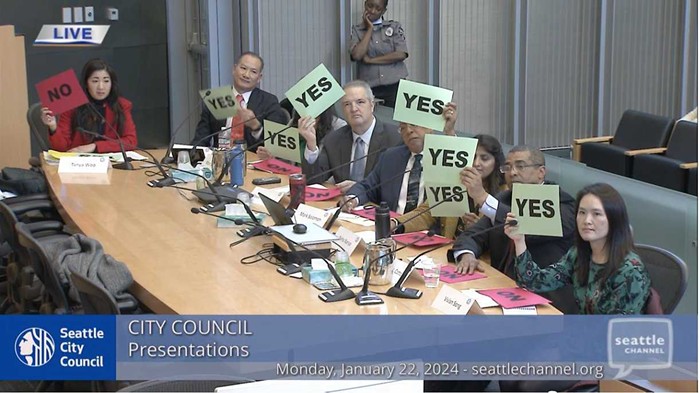The debate over the fate of SR-520: A clear choice between imperfect transit and no transit at all, or a triumph of false consciousness over rational discussion?
That wasn't exactly how the proponents of two clashing proposals for replacing the SR-520 bridge characterized the debate at the city council meeting on April 16, but it's as good a summation as any: Supporters of a six-lane replacement claimed it would provide real transit on 520, connecting buses to the planned light-rail station at Husky Stadium. Opponents, who supported replacing the 520 bridge with a slightly wider four-lane structure, claimed that any six-lane option would divert traffic into the Arboretum, destroy Marsh Island, and open 520 to worse gridlock than ever.
I, meanwhile, have had a hard time wrapping my mind around either option: Yes, transit to the Eastside is necessary, but couldn't we accomplish that goal without expanding the freeway from 60 feet to 133 feet? Here's a modest proposal: What about a four-lane option that didn't allow any single-occupancy cars at all: Two lanes of transit and two for high-occupancy vehicles? (Or—compromise!—an HOV lane that allows single-occupancy cars on for a toll?) Everyone, from the mayor to Richard Conlin, says we have to think differently about how we define mobility. Maybe it's time to really act on it.
Peter Steinbrueck's proposal to "disperse" strip clubs throughout the city may not pass muster with strip clubs themselves, whose lobbyist, Tim Killian, says it could leave clubs "without the ability to open anywhere." That's a slight exaggeration—the proposal would allow clubs in any commercial zone more than 800 feet from parks, day cares, schools, and libraries—but not entirely off-base, either: The legislation would allow clubs only in a few small areas, including a swath of south downtown by the stadiums and a chunk of industrial Ballard. Killian argues that since "no one has even tried to open a strip club" in a year, the best alternative is to do nothing. Steinbrueck counters, "Just because there hasn't been interest in the last few months doesn't mean there won't ever be."
Council President Nick Licata prevailed in his effort to get a new sergeant assigned to the Office of Professional Accountability, the Seattle Police Department's self-policing arm. The OPA's average time to complete investigations has been slipping—to 119 days in 2006, 29 days longer than the 90-day-maximum goal. Last year, the council allocated $120,000 to hire a sergeant to do internal investigations, but Police Chief Gil Kerlikowske decided not to fill the position. Last week, however, Licata convinced the police chief to move a sergeant temporarily into the position. "I think he came to understand that there was a pretty strong paper trail" in support of the new position, Licata says. If investigation times improve, the money could be allocated in next year's city budget. ![]()


















